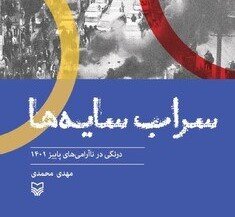The illusion of imminent collapse

TEHRAN - In Chapter 3 of 'Mirage of Shadows,' Mehdi Mohammadi delved into the West's targeted focus on three key groups—women, influencers, and Generation Z—to instigate and perpetuate riots.
In the subsequent chapter, he reveals that the meticulous planning by the West and Israel for the events leading to the turmoil following Mahsa Amini's passing had actually commenced far ahead of her death.
As previously discussed by the author, Western powers and Israel view the Leader of the Islamic Revolution as their primary adversary and the main hurdle that has effectively withstood their pressures over the decades. Their perspective suggests that any attempts to significantly weaken Iran and mar its regional clout would only succeed once Ayatollah Seyyed Ali Khamenei is no longer in the picture. Hence, although Israel and the West were aware that the 2022 riots were unlikely to result in the overthrow of the Islamic Republic, they aimed to create circumstances where rioters could potentially regain momentum and determination upon realizing that the Leader of the Islamic Revolution for whatever reason, would no longer be able to stand them.
Understanding the pivotal role of Ayatollah Khamenei sheds light on two critical events that happened before the passing of Mahsa Amini.
The first event pertains to a declaration made by a figure considered a significant asset of the West, Mirhossein Mousavi. Mousavi, alongside Mehdi Karroubi, triggered the post-election unrest in 2009, regarded as a pivotal moment in influencing Western policies towards Iran. It was during this turbulent period that the U.S. leveraged the tumultuous environment as a pretext to impose severe sanctions on Iran. Mousavi's assertion at the time, alleging electoral fraud by former president Mahmoud Ahmadinejad, was vehemently refuted by authorities and was never proven to hold any water.
The statement released months before the 2022 riots warned about 'Hereditary Rule' in Iran and alleged that Ayatollah Khamenei’s son would be succeeding him as the leader.
While the statement, now revealed to have been written by an MKO-affiliated figure named Ardeshir Amirarjomand and published without Mousavi’s notice, offered no evidence as to why such claims were being made, it did presage a grand scheme by the West and Israel aiming to undermine Iran’s security.
A while later the New York Times claimed to have heard from people familiar with the leader’s health situation that Ayatollah Khamenei was gravely ill and is currently on bed rest under observation by a team of doctors.
The New York Times persisted in its false claims even after the Leader made a public appearance and visited a military academy in full health. While the New York Times’ assertions seemed eerie back then, once the 2022 riots happened many figured out the reason for the blatant lies.
The West and Israel sought to influence the Iranian public by suggesting that the Islamic Republic was more vulnerable than it was in 2009 due to the absence or imminent absence of the Leader. Anyone who had taken part in previous riots in Iran could take to the streets once again as the situation was completely different; the most important figure keeping the Islamic Republic together was now gone and it was easier than ever to topple the government.
The fake news created throughout the course of the riots can be looked at through the same prism. The story of the fall of Oshnavieh, the fleeing of Iranian authorities to Venezuela, and the substantial rift within the armed forces all aimed to portray the Iranian government as an endangered entity on the verge of collapse. This helped embolden the rioters to commit more violent acts against security forces, thinking that they were on the verge of a full-on “revolution” and thus would never have to face reckoning for their acts.
To be continued...
Leave a Comment